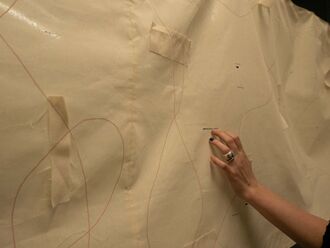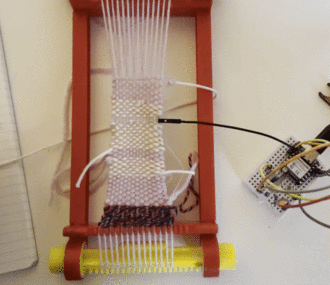User:Anita!/assesmentT4
Fake assesment
Why do you want to make it?
Sound connects. It is not tangible but exists so powerfully in space. It identifies places so distinctively but is not usually thought of or used to describe one other than ‘noisy’ or ‘silent’. Imagining and playing with mundane sounds, exploring the urban landscape with no visual aid, to notice and create new imaginary paths. Re-publishing existing and real-life 'boring' common sounds. Every time someone plays with the project, it will have a unique quality to it. The player will likely not be able to repeat the sequence of sounds, making the soundscape so subjective depending on the performer, much like the sound of the city. Listening is something so important to me, and I would like for this project to turn players into 'listeners'. It is an invitation to notice these differences in the city soundscape, the small tone changes and how sequences of sound vary each time they happen.
Fabric, like sound, is so textured. It invokes memories, feelings and is such a malleable and ever changing material. It is flexible and can adapt and bounce around its surroundings like a liquid, or like sound itself. Like city noise, its texture is so ordinary that it becomes almost invisible.
Another really important part of the piece to me, is the process of making it itself, spending time in squares, observing and listening to their dynamics. Collecting discarded fibers (e.g. a single glove), and collecting 'discarded' sounds. Making my own sensors with these materials from scratch. Manually spinning, knitting and weaving all of this material to bring it together again, in another form.
What do you want to make?
For the graduation project, I want to make a large scale textile soundboard (made as an interactive textile), containing a series of noises collected from public spaces, more specifically squares. This is because the squares form, place and function have historically (and still today) contributed to the urban development and feel of the city.
The instrument can be played to create different public soundscapes, inviting the person interacting with it to listen, move and imagine a path. Different points produce different sounds caught in the city. The person playing has to move and 'perform' a distinct choreography each time because of the distance between the triggers playing the sounds, enhancing the physicality and embodying the soundscape.
Playing allows the user to let go of expectations and predictability, enhances chances and small changes, and helps notice things from another perspective. I would like the 'player' to take away from the experience, is the notion that city soundscapes are really worth listening to, they are so rich in information and contradistinct from one another, adding a layer to the definition of public space itself.
The fibers used for the production of the soundboard will partly be sourced from the squares where the listening and capturing of the sounds will occur. They will be washed, taken apart (perhaps dyed) and re-spun (by me) into yarn. This will be done to create a stronger connection to where the sounds originate from. The rest of the fibers used will be natural (wool), because of its specific soft and inviting texture.
How do you plan to make it?
To be able to create this soundboard, I have identified a few crucial development elements: Learn how to make my own conductive yarn, spin test yarn with different concentrations of metal and test them out on smaller circuits. Collect fibers, wash and re-spin them into yarn that I will use for the textile.
Collect sounds, and fibers from squares in Rotterdam. This will be done by using a series of different listening methods, experiments and exercises I will come about during the development of the project. These methods will be documented and explained in the thesis, and they will set the tone for playful listening.
Design and test an 'interface' for the textile, decide the spacing between the sensors on a prototype circuit, have many people dance to it.
Work on small experiments of patches as well as installation shapes to test touch and find what people are drawn to interact and really play with.
Relation to previous practice
I feel very connected to both listening and traditional garment construction techniques. Working with textiles is something that has been present again and again in my practice.
Before starting Xpub, I studied Industrial Product Design, and I focused on designing and producing soft objects out of fabric and paper. I also worked in a fashion Atelier for 6 months, mainly producing prints and patterns for textiles, sewing by hand and working with a mixture of delicate soft materials, metal and mylar to create sculptural garments.
In Special Issue 22, I worked on the 'curtain', a sewn modular archive as an element to 'safekeep' and protect the different projects, sounds and survival tools that were created for the SI. I also focused a lot on field recording, exploring sound in public space and interactive radio making (with Hitchikers Guide to an Active Archive with Thijs and Rosa).
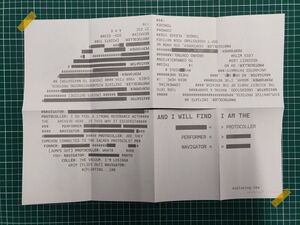
|
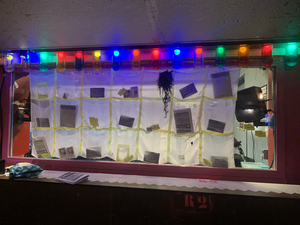
|
In Special Issue 23, I was really inspired to work with word/sentence manipulation, connecting it with sewing and quilting. I made experiments with sewing on paper, trying to create a very literal word quilt. I wanted to try to show the 'infrastructure' of my thoughts while reading and annotating these texts in a visual way, incorporating the seams metaphor quite literally. I tried to connect ideas from different texts by making a sewn collage.
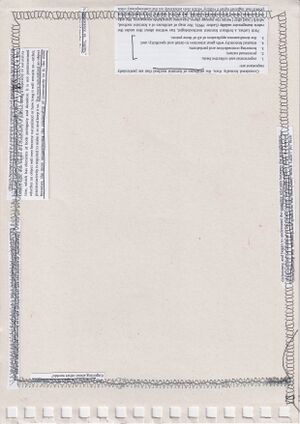
|
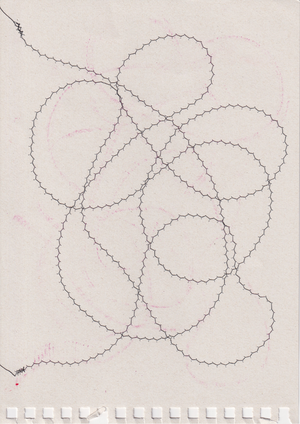
|
In Special Issue 24, I worked with a very similar research topic to what I will be looking into in the graduation project and thesis, focusing on listening in public space, using textiles and paper to translate the sound. I worked on 'Knitting City Noise' a work in progress that focused on static listening, from one fixed point of view by using a sound sensor in Marconi Plein. From that, the sensor recorder yes sound or no sound based on the loudness around it. I then translated this nominal data to a punch card for knitting and am currently knitting it.
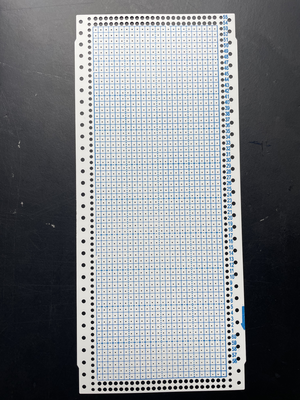
|
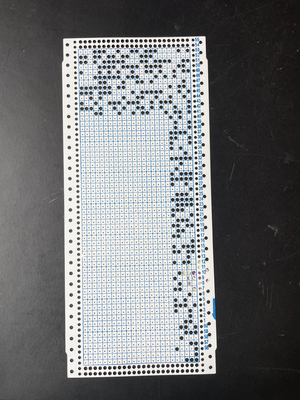
|
I also recorded sound while moving, in a series of walks, runs and cycles around Rotterdam. I then listened back and wrote down all the sounds I heard as a list, screen printed them onto cotton and sewed the paths of the recordings creating a subjective sound map of the city.

|
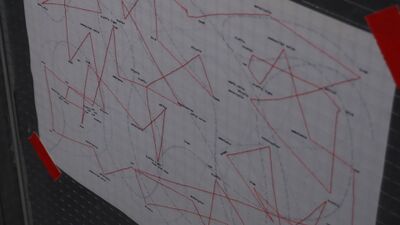
|
I also worked on 'Scripts to read the City' with Mania, a publication containing a series of scripts to look and listen in public space. The project imagines an urban environment that can be read, analyzed and criticized as a text. By reading the city in this way we find other possible ways of seeing, moving and listening. In a scripted city, marked by escalating levels of perfection, efficiency and control, the emancipatory aspects of urban life are undermined, allowing little room for anything that doesn't fit the image of the "norm".
Scripts to Read the City is an attempt to foster diverse experiences and uses of space, similar to a theater script interpreted differently by each actor. The tools of navigation are a device indicating which character to play and a guide, including a set of directions and instructions.
The project explores a relation between scripts and spontaneity, chance and control, and how scripts and unpredictability can enhance each other, stimulating imagination, encouraging us to engage with space from another perspective.
We also held a workshop based on the publication at SIGN in Groningen as a part of Spread Zinefest.
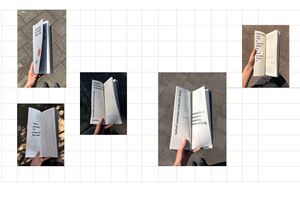
|
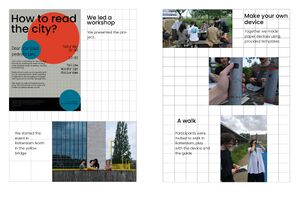
|
References
Deep Listening A Composer's Sound Practice, Pauline Oliveros
Walking, Listening and Soundmaking, Elena Biserna
Walking from scores, Elena Biserna
LISTEN, Max Neuhaus
Inaudible Cities, Jacek Smolicki
Listening: A Research Method in Art & Design, edited by Alice Twemlow
Basta Now: women, trans & non-binary in experimental music, Fanny Chiarello
Smooth City, Renè Boer
The rest is noise, Alex Ross
Scratch Music, Cornelius Cardew

